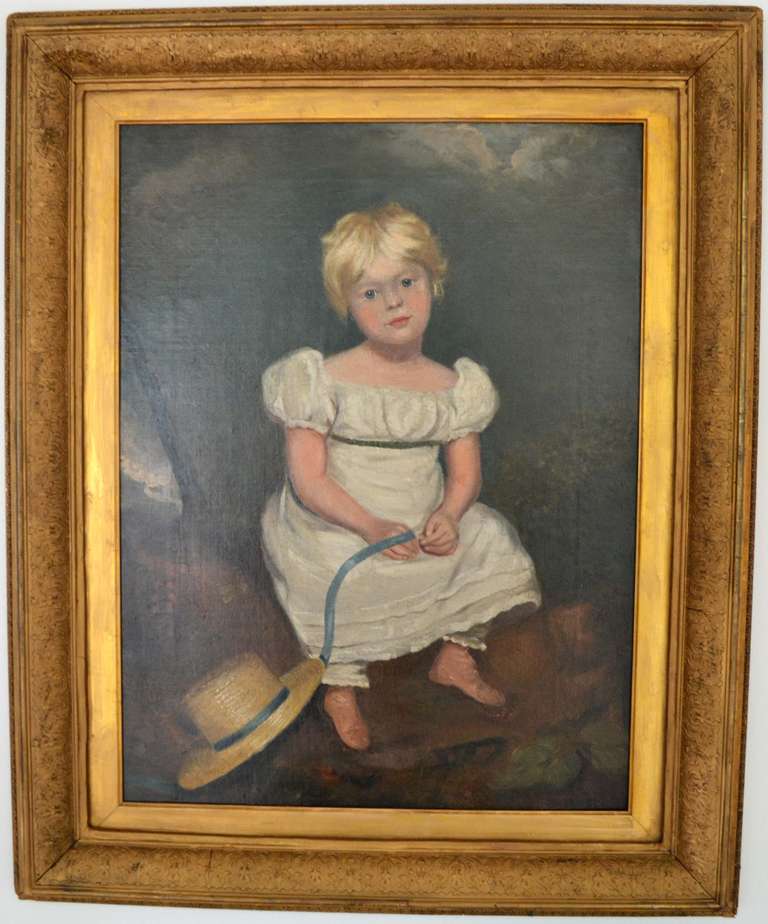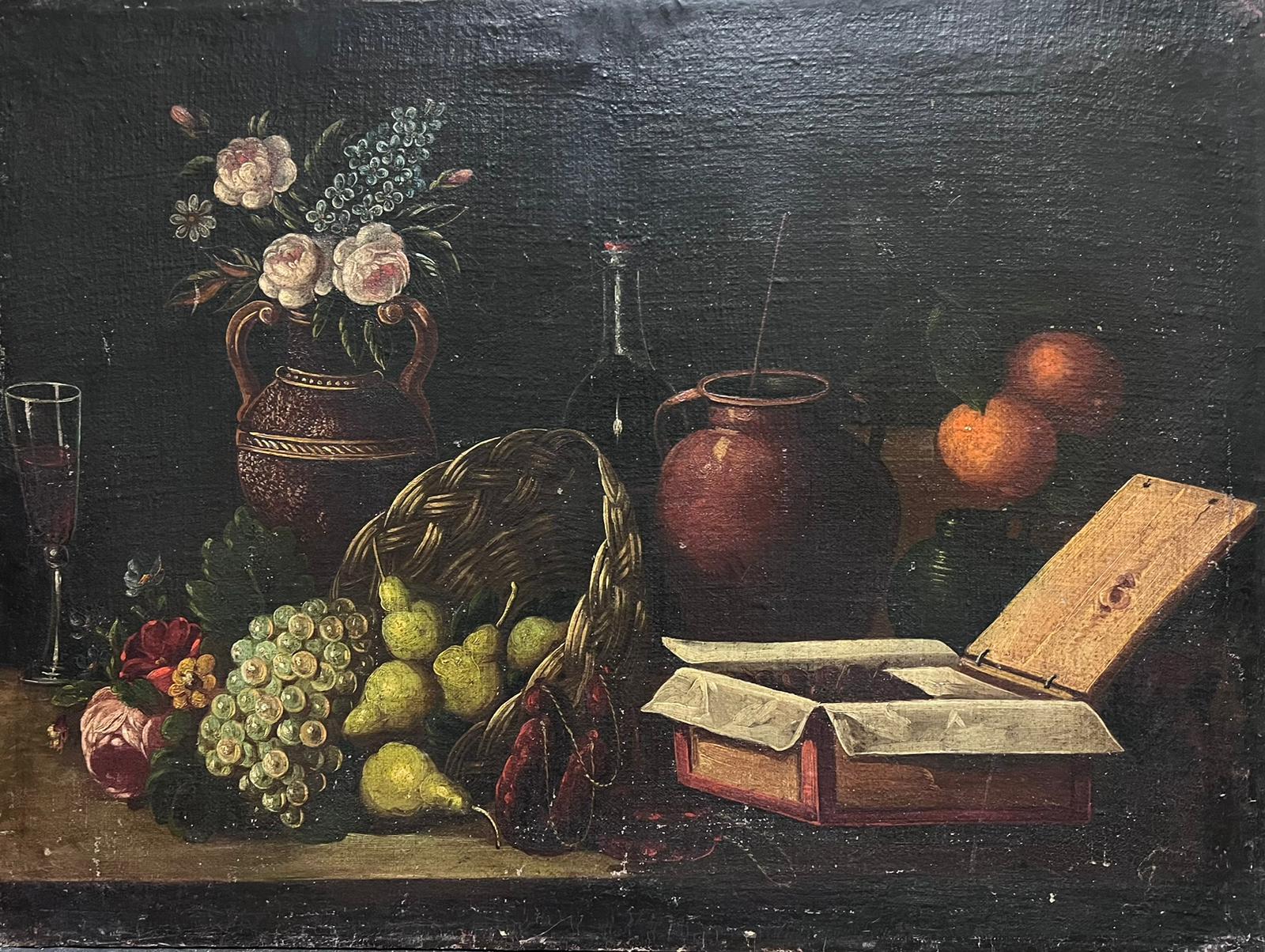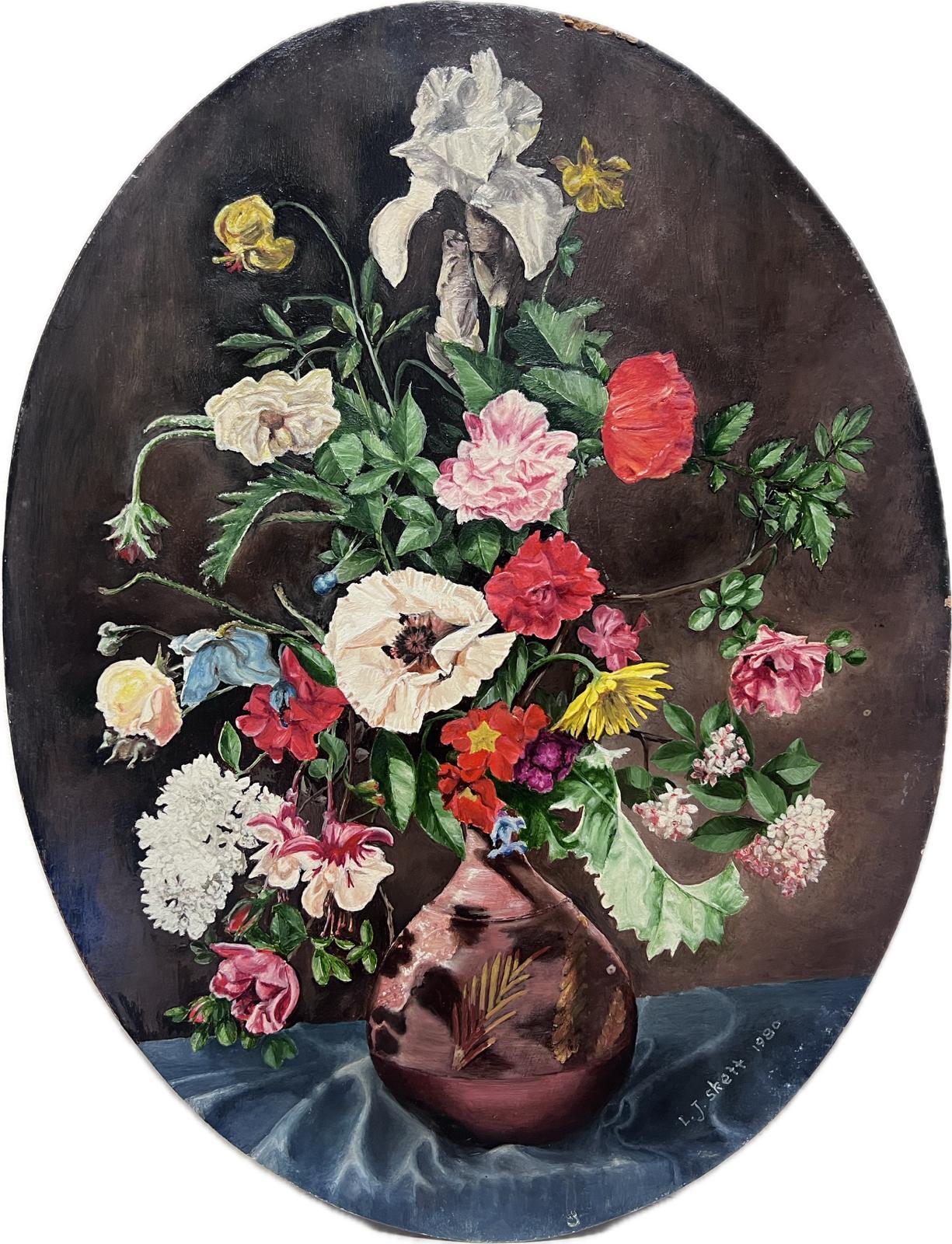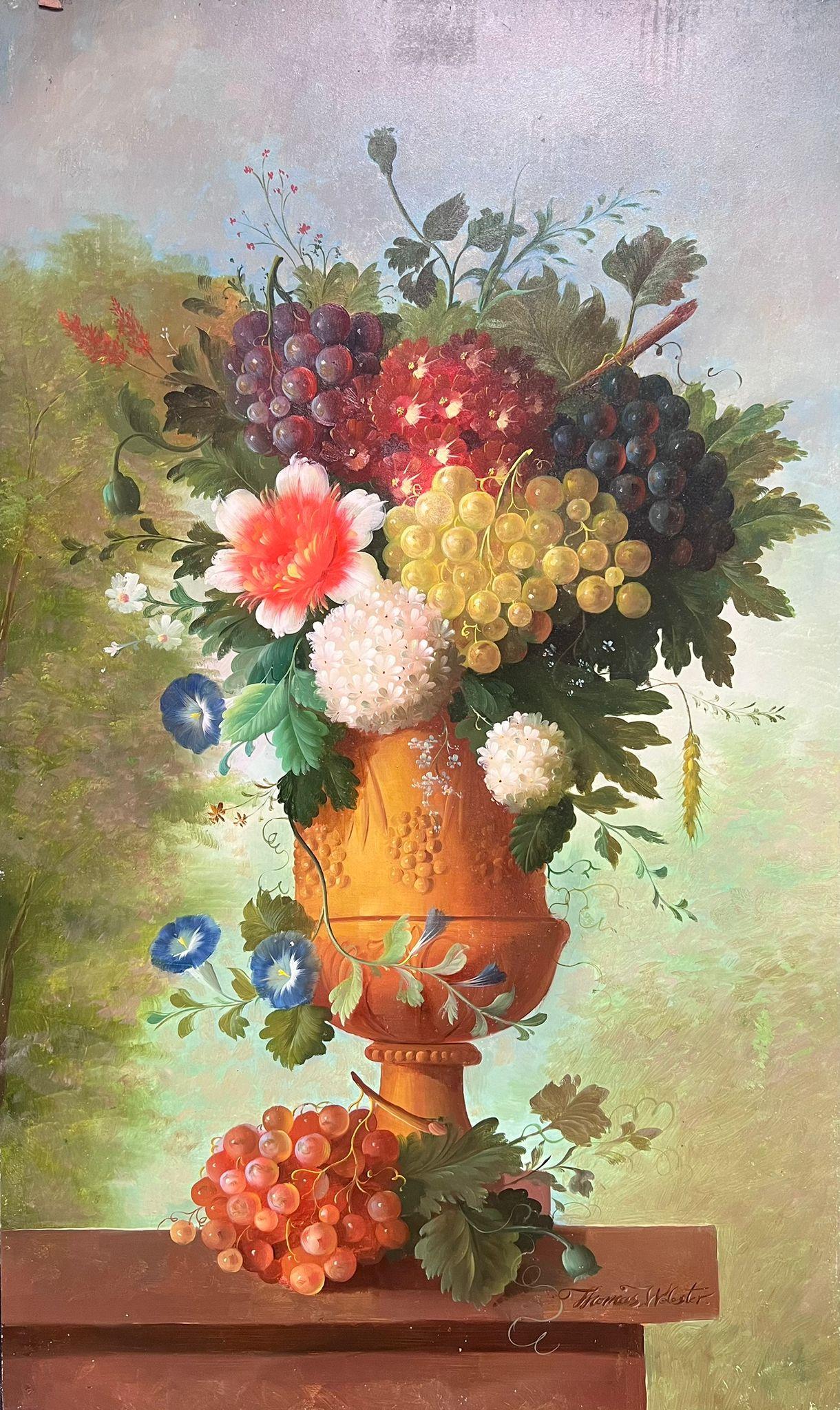Items Similar to Still-Life Flower Landscape Castelli Paint Oil on canvas Old master Italian art
Video Loading
Want more images or videos?
Request additional images or videos from the seller
1 of 19
Still-Life Flower Landscape Castelli Paint Oil on canvas Old master Italian art1690-1740
1690-1740
About the Item
Still life in a landscape with fruit and game
Work of the late Roman Baroque of the late seventeenth / eaarly eighteenth century
attributable to Giovanni Paolo Castelli, known as Spadino (Rome, 1659 - 1730)
oil on canvas
62 x 76 cm., Framed 90 x 109 cm.
An open-air setting, with a hilly landscape gash that opens into the distance in the central part, surrounds our beautiful canvas, which showcases a rich selection of game and fruit, arranged in the foreground near the point of view of the observer, occupying a large part of the visual field with their bright and festive colors.
The style and quality of the work, like the pictorial technique of this still life, characterized by subtle luminous vibrations and a lively chroma, make it attributable to the Roman Giovanni Paolo Castelli, known as Lo Spadino (Rome, 1659 - 1730), one of the most important specialists of this pictorial genre of late Baroque Rome, which had a very successful career between the 17th and 18th centuries.
Analyzing the rich and heterogeneous catalog of the Roman master, in fact, our canvas can be included among his rare works which, alongside a selection of fruit - among which stand out large melons, ripe figs, dark grapes and plums - we see a game advert, presumably as requested by a patron who loves hunting. Next to various birds, spoils of a profitable hunting trip, there is also a small green woodpecker, with the characteristic red spot on the head, and a nice rodent that terminates from behind the trunk.
The painter abandons himself to a skilful and brilliant chromatic texture of the surfaces, through a pictorial material rendered with exceptional vibration in its luminous and 'tactile' body, fully respecting the taste of the full Roman Baroque.
The quality appears excellent, distinguished by a skilful and brilliant chromatic texture of the surfaces, which appear almost vibrant thanks to a skilful drafting of the pictorial material.
Inevitable and evident are the Flemish suggestions, which had influenced the Roman Baroque still life, in particular the work of Abraham Brueghel.
Giovanni Paolo Castelli could boast a family workshop (in which his brother and son worked) long appreciated in the Rome of the second half of the seventeenth century, specialized in the genre of still life, which allowed him to quickly achieve considerable fame, working for the most important Roman families, such as the Chigi, Cardinal Pamphili who owned eleven Spadino, the Spada and the Rospigliosi.
By way of comparison, among the works similar to ours, similar in scenic and stylistic organization, we can mention:
- Still life with melon, peaches, grapes, game, guinea pig and hens, Sotheby's, New York, January 17, 1992, and now Private collection,
- Still life with pomegranates, peaches, plums and birds (Private collection, Gardone
- Still life with fruit and parrot, "Domenico Inzaghi" Civic Art Gallery, Budrio
- Still life with fruit, mushrooms and bird, Antiques market, Verona
- Still life with watermelon, peaches, grapes and pomegranate, "Fortunato Duranti" Civic Art Gallery, Montefortino
- Still life with melon, watermelon, peaches, grapes, figs and pomegranate, Private Collection
- Still life with fruit, jug and bird, Palazzo Blu, Fondazione CariPisa collection, Pisa
The painting is completed by a pleasant antique frame that suits it well and is sold with a certificate of authenticity in accordance with the law.
- Attributed to:Giovanni Paolo Castelli, known as Spadino (Rome, 1659 - 1730) (1659 - 1730, Italian)
- Creation Year:1690-1740
- Dimensions:Height: 35.44 in (90 cm)Width: 42.92 in (109 cm)
- Medium:
- Movement & Style:
- Period:Late 17th Century
- Condition:
- Gallery Location:Riva del Garda, IT
- Reference Number:1stDibs: LU98818680702
About the Seller
4.8
Platinum Seller
These expertly vetted sellers are 1stDibs' most experienced sellers and are rated highest by our customers.
Established in 2017
1stDibs seller since 2018
202 sales on 1stDibs
Typical response time: <1 hour
- ShippingRetrieving quote...Ships From: Riva del Garda, Italy
- Return PolicyA return for this item may be initiated within 7 days of delivery.
More From This SellerView All
- De Wit Flowers Still life Paint Oil on canvas 18th Century Flemish Cupids ArtLocated in Riva del Garda, ITJacob De Wit (Amsterdam, 1695 - 1754) attributable/ workshop Pair of Cupids with Garland of Flowers Oil on canvas 91 x 103 cm. - Framed 104 x 115 cm. Provenance: Christie's (London, Old master Painting 12.12.1996) lot 82 This magnificent composition depicts two cupids holding a garland of flowers, placed on a fine architecture with bas-reliefs and masks, presumably the top of a fountain. One of the two cupids sympathetically holds a part of it with his hands, while his head turns towards the viewer; the second cupid, on the other hand, must have clumsily broken the thread holding its end, and is sitting sullenly with a torch and a tear streaking his chubby cheek. The work, given its stylistic features and compositional taste, can be attributed to the Flemish artist Jacob de Wit (Amsterdam, 1695 - 1754), or to an artist from his workshop, with his typical triumphal and opulent style, which reveals clear influences from Rubens and Van Dijck, but also from Gerard de Lairesse...Category
18th Century Old Masters Paintings
MaterialsOil
- Flower Garland Virgin Paint Oil on canvas Old master 17th Century ItalyBy Giovanni StanchiLocated in Riva del Garda, ITGiovanni Stanchi (Rome 1608 - 1675) or Niccolò Stanchi (Rome 1623 - 1690), workshop of GARLAND OF FLOWERS WITH PORTRAIT OF THE VIRGIN Rome, First half of the Seventeenth century o...Category
17th Century Old Masters Paintings
MaterialsOil
- Still-life Flower Paint Oil on canvas Old master 17th Century Lombard schoolLocated in Riva del Garda, ITFrancesca Volò Smiller, called Vincenzina (Milan, 1657 - 1700) - circle of Floral composition Oil on canvas (97 x 72 cm. - in octagonal frame 100 x 84 cm.) A rich floral compositio...Category
17th Century Old Masters Paintings
MaterialsOil
- Still Life Vanitas Noletti Paint Oil on canvas Old master 17th Century ItalianLocated in Riva del Garda, ITFrancesco Noletti known as the Maltese (Malta 1611-Rome 1654) Workshop/circle of Still life with musical instruments, toys, armour, textiles and precious objects Oil on canvas (52 x...Category
17th Century Old Masters Paintings
MaterialsOil
- Angels Flower Garzi Paint Oil on canvas Old master 17/18th Century Italian ArtBy Luigi Garzi (Pistoia 1638– Rome1721)Located in Riva del Garda, ITRoman school of the early 18th century Luigi Garzi (Pistoia 1638– Rome1721) attributed Still life of fruit supported by three angels Oil on oval canvas 116 x 91 cm., Framed 140 x 119 cm. Authentication on a photograph by Prof Giancarlo Sestieri, who attributes the work to the sphere of Luigi Garzi This magnificent canvas, depicting a sumptuous composition of fruit supported by three prosperous winged cherubs, from which comes a parchment bearing the Latin expression "Amor est vitae essentia", is to be placed in the production of a Roman author active between the second half of XVII century and the first of the following century. The iconography that sees represented cherubs with fruit or flowers is frequent in the Baroque period, especially in the Roman area, starting from the 1600s, with that particular depictional tendency aimed at illusionistic and frivolous images, to a type of paintings or frescoes of strong value decorative, intended for the private context and depicting jubilation of cherubs, angels or cherubs, and of which our canvas represents a perfect example. We can recall, among the most illustrious iconographic precedents, the elegant mirrors painted by Mario Nuzzi and Carlo Maratta that adorn the hall of Palazzo Colonna in Rome, and again the canvas preserved in the Rouen museum and the similar ones in Palazzo Chigi in Ariccia, with the collaboration for the figurative parts of Filippo Lauri. The commercial and furnishing success of similar works is also testified by authors such as Guglielmo Cortese known as Borgognone (1628 - 1679), Franz Werner Von Tamm (1658 - 1724), Giovan Battista Gaulli (1639 - 1709), Giovanni Paolo Castelli known as Spadino (Rome 1650 - 1740) and the aforementioned Carlo Maratta (1625 - 1713) The work, studied by Giancarlo Sestieri, was brought closer to the sphere of the eclectic Pistoian painter Luigi Garzi, one of the protagonists of Roman painting in the decades of transition between the seventeenth and eighteenth centuries. In our painting we can find the typical elements of his painting: the soft and delicately chiaroscuro light, the sculptural classicism of the figures as well as the stupendous luministic and chromatic effects. Luigi Garzi's training and artistic activity took place in the Eternal City and he was in effect a Roman artist. He moved to Rome from Pistoia, his hometown at a very young age, and joined the atelier of Andrea Sacchi, who directed his studies towards classicism, comparing himself with the works of Raphael, Domenichino and Nicolas Poussin, but also with the Emilian one. , with particular attention to the school of Guido Reni. But the Emilian examples were undoubtedly preceded, particularly by Giovani Lanfranco, who modeled his taste and style, together with a modulated cortonism, while those pre-eighteenth-century sensibilities are due to the lesson of Carlo Maratta. However, there is no doubt that the painter oriented his personality without ever bowing to imitation, reaching a refined elegance and autonomy of language, as the canvas in question clearly demonstrates in which the different influences find a refined amalgamation in perfect harmony with the baroque evolution between the seventeenth and eighteenth centuries, indicating a dating to its earliest maturity. These attitudes led the painter to obtain awards and prestigious commissions as soon as possible, such as the frescoes of Palazzo Borghese...Category
Late 17th Century Old Masters Paintings
MaterialsOil
- Flowers Paint Oil on canvas Old master 17th Century Italy Still-life ArtLocated in Riva del Garda, ITMaster of the Grotesque Vase (active in Rome and Naples in the first quarter of the 17th century) Still life of flowers in a classic vase oil on canvas 66 x 51 cm, In frame cm. 82 x...Category
17th Century Old Masters Paintings
MaterialsOil
You May Also Like
- Pair of 17th century Flemish still-life with flowers - Roses, tulips and peoniesLocated in Antwerp, BEPair of large and opulent 17th century Flemish floral still lifes by the celebrated artist Gaspar Pieter Verbruggen I Our paintings depict opulent floral arrangements consisting of,...Category
17th Century Old Masters Still-life Paintings
MaterialsCanvas, Oil
- Young Girl after Sir Thomas Lawrence, Regency portrait paintingLocated in Brecon, PowysCharming work in the Regency style, mid 19th Century after Sir Thomas Lawrence. High quality painting. Old Christie's Stencil to verso. Would grace any home, suitable for contempor...Category
Mid-19th Century Old Masters Portrait Paintings
MaterialsCanvas, Oil
- Huge 18th Century Italian Old Master Oil Painting Still Life Fruit Flowers & JugLocated in Cirencester, GloucestershireClassical Still Life of Fruit in Basket with other objects Italian artist, 18th century oil on canvas, unframed canvas: 24.5 x 33 inches provenance: private collection, UK condition:...Category
18th Century Old Masters Still-life Paintings
MaterialsOil
- Huge 18th Century Italian Old Master Oil Painting Still Life Fruit in BasketLocated in Cirencester, GloucestershireClassical Still Life of Fruit in Basket with other objects Italian artist, 18th century oil on canvas, unframed canvas: 24.5 x 33 inches provenance: private collection, UK condition:...Category
18th Century Old Masters Still-life Paintings
MaterialsOil
- Fine Classical Still Life Flower Painting Signed & Dated English OilLocated in Cirencester, GloucestershireClassical Still Life of Flowers English artist, 20th century signed oil on board, unframed dated 1980 board: 14.5 x 11.5 inches provenance: private collection, UK condition: overall ...Category
20th Century Old Masters Still-life Paintings
MaterialsOil
- Huge Classical Still Life Flowers & Fruit Still Life in Stone Urn Oil PaintingLocated in Cirencester, GloucestershireProfusion of Flowers by Thomas Webster, British contemporary artist, late 20th century signed oil on board, unframed board: 30 x 18 inches provenance: private collection, UK conditi...Category
Late 20th Century Old Masters Still-life Paintings
MaterialsOil
Recently Viewed
View AllMore Ways To Browse
Art As Antique
Old Antique Art
Antique Italian Art
Antique Flower Art
Large Flowers Art
Still Life Flowers
Flower Oil Paint
Italian Love Art
Old Flower
Canvas Painted Flowers
Arranging Art
Framed Gallery Art Italian
Flower Landscapes
Luminous Art
Painting Italy Rome
Italian Painting Rome
Paintings Of Rome Italy
Art For Law





